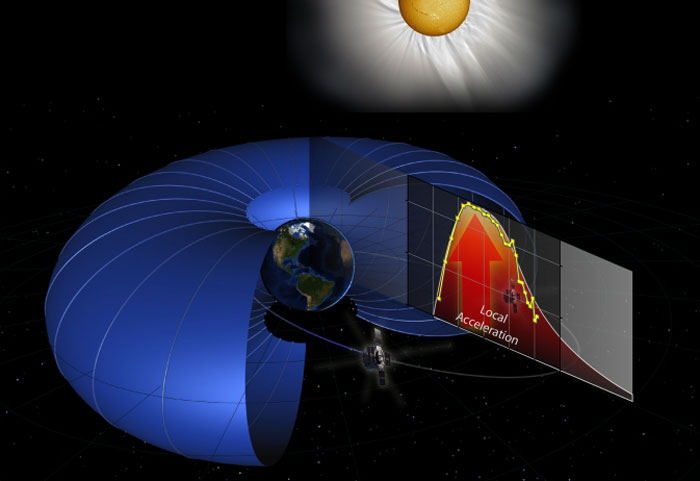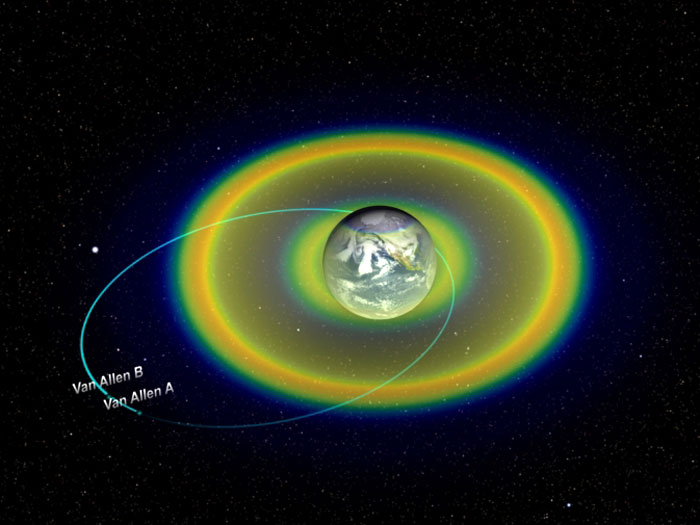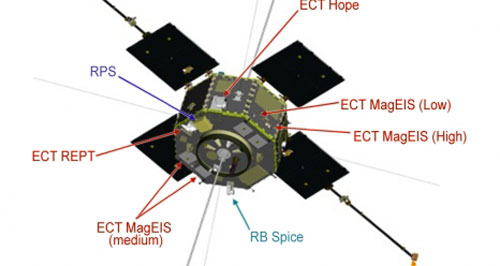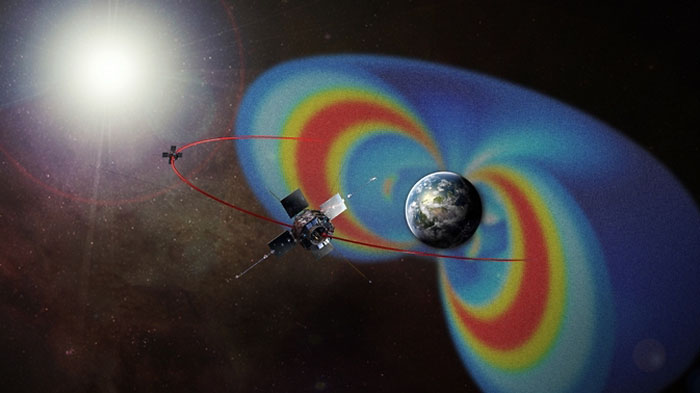.
26.07.2013

Recent observations by NASA’s twin Van Allen Probes show that particles in the radiation belts surrounding Earth are accelerated by a local kick of energy, helping to explain how these particles reach speeds of 99 percent the speed of light.
Image Credit: G. Reeves/M. Henderson
.
Scientists have discovered a massive particle accelerator in the heart of one of the harshest regions of near-Earth space, a region of super-energetic, charged particles surrounding the globe called the Van Allen radiation belts. Scientists knew that something in space accelerated particles in the radiation belts to more than 99 percent the speed of light but they didn't know what that something was. New results from NASA's Van Allen Probes now show that the acceleration energy comes from within the belts themselves. Particles inside the belts are sped up by local kicks of energy, buffeting the particles to ever faster speeds, much like a perfectly timed push on a moving swing.
The discovery that the particles are accelerated by a local energy source is akin to the discovery that hurricanes grow from a local energy source, such as a region of warm ocean water. In the case of the radiation belts, the source is a region of intense electromagnetic waves, tapping energy from other particles located in the same region. Knowing the location of the acceleration will help scientists improve space weather predictions, because changes in the radiation belts can be risky for satellites near Earth. The results were published in Science magazine on July 25, 2013.
In order for scientists to understand the belts better, the Van Allen Probes were designed to fly straight through this intense area of space. When the mission launched in August 2012, it had top-level goals to understand how particles in the belts are accelerated to ultra-high energies, and how the particles can sometimes escape. By determining that this superfast acceleration comes from these local kicks of energy, as opposed to a more global process, scientists have been able to definitively answer one of those important questions for the first time.
"This is one of the most highly anticipated and exciting results from the Van Allen Probes," said David Sibeck, Van Allen Probes project scientist at NASA's Goddard Space Flight Center in Greenbelt, Md. "It goes to the heart of why we launched the mission."
The radiation belts were discovered upon the launch of the very first successful U.S. satellites sent into space, Explorers I and III. It was quickly realized that the belts were some of the most hazardous environments a spacecraft can experience. Most satellite orbits are chosen to duck below the radiation belts or circle outside of them, and some satellites, such as GPS spacecraft, must operate between the two belts. When the belts swell due to incoming space weather, they can encompass these spacecraft, exposing them to dangerous radiation. Indeed, a significant number of permanent failures on spacecraft have been caused by radiation. With enough warning, we can protect technology from the worst consequences, but such warning can only be achieved if we truly understand the dynamics of what's happening inside these mysterious belts.
"Until the 1990s, we thought that the Van Allen belts were pretty well-behaved and changed slowly," said Geoff Reeves, the first author on the paper and a radiation belt scientist at Los Alamos National Laboratory in Los Alamos, N.M. "With more and more measurements, however, we realized how quickly and unpredictably the radiation belts changed. They are basically never in equilibrium, but in a constant state of change."
In fact, scientists realized that the belts don't even change consistently in response to what seem to be similar stimuli. Some solar storms caused the belts to intensify; others caused the belts to be depleted, and some seemed to have almost no effect at all. Such disparate effects from apparently similar events suggested that this region is much more mysterious than previously thought. To understand – and eventually predict – which solar storms will intensify the radiation belts, scientists want to know where the energy that accelerates the particles comes from.
The twin Van Allen Probes were designed to distinguish between two broad possibilities on what processes accelerate the particles to such amazing speeds: radial acceleration or local acceleration. In radial acceleration, particles are transported perpendicular to the magnetic fields that surround Earth, from areas of low magnetic strength far from Earth to areas of high magnetic strength nearer Earth. The laws of physics dictate that the particle speeds in this scenario will speed up when the magnetic field strength increases. So the speed would increase as the particles move toward Earth, much the way a rock rolling down hill gathers speed simply due to gravity. The local acceleration theory posits that the particles gain energy from a local energy source more similar to the way hot ocean water spawns a hurricane above it.
.

Two swaths of particles surrounding Earth called the radiation belts are one of the greatest natural accelerators in the solar system, able to push particles up to 99% the speed of light. The Van Allen Probes launched in August 2012, have now discovered mechanisms behind this acceleration.
.
To help distinguish between these possibilities, the Van Allen Probes consist of two spacecraft. With two sets of observations, scientists can measure the particles and energy sources in two regions of space simultaneously, which is crucial to distinguish between causes that occur locally or come from far away. Also, each spacecraft is equipped with sensors to measure particle energy and position and determine pitch angle – that is, the angle of movement with respect to Earth's magnetic fields. All of these will change in different ways depending on the forces acting on them, thus helping scientists distinguish between the theories.
Equipped with such data, Reeves and his team observed a rapid energy increase of high-energy electrons in the radiation belts on Oct. 9, 2012. If the acceleration of these electrons was occurring due to radial transport, one would measure effects starting first far from Earth and moving inward due to the very shape and strength of the surrounding fields. In such a scenario, particles moving across magnetic fields naturally jump from one to the next in a similar cascade, gathering speed and energy along the way – correlating to that scenario of rocks rolling down a hill.
But the observations didn't show an intensification that formed further away from Earth and gradually moved inward. Instead they showed an increase in energy that started right in the middle of the radiation belts and gradually spread both inward and outward, implying a local acceleration source.
"In this particular case, all of the acceleration took place in about 12 hours," said Reeves. "With previous measurements, a satellite might have only been able to fly through such an event once, and not get a chance to witness the changes actually happening. With the Van Allen Probes we have two satellites and so can observe how things change and where those changes start."
Scientists believe these new results will lead to better predictions of the complex chain of events that intensify the radiation belts to levels that can disable satellites. While the work shows that the local energy comes from electromagnetic waves coursing through the belts, it is not known exactly which such waves might be the cause. During the set of observations described in the paper, the Van Allen Probes observed a specific kind of wave called chorus waves at the same time as the particles were accelerated, but more work must be done to determine cause and effect.
"This paper helps differentiate between two broad solutions," said Sibeck. "This shows that the acceleration can happen locally. Now the scientists who study waves and magnetic fields will jump in to do their job, and find out what wave provided the push."
Luckily, such a task will also be helped along by the Van Allen Probes, which were also carefully designed to measure and distinguish between the numerous types of electromagnetic waves.
.

Instruments on Van Allen Probes
.
“When scientists designed the mission and the instrumentation on the probes, they looked at the scientific unknowns and said, ‘This is a great chance to unlock some fundamental knowledge about how particles are accelerated,’” said Nicola J. Fox, deputy project scientist at the Johns Hopkins University Applied Physics Laboratory in Laurel, Md. “With five identical suites of instruments on board twin spacecraft – each with a broad range of particle and field and wave detection – we have the best platform ever created to better understand this critical region of space above Earth.”
The Applied Physics Laboratory built and operates the twin Van Allen Probes for NASA’s Science Mission Directorate. The Van Allen Probes comprise the second mission in NASA's Living With a Star program, managed by Goddard, to explore aspects of the connected sun-Earth system that directly affect life and society.
.
Quelle: NASA
.
Update: 16.07.2014
.
NASA's Van Allen Probes Show How to Accelerate Electrons

One of the great, unanswered questions for space weather scientists is just what creates two gigantic donuts of radiation surrounding Earth, called the Van Allen radiation belts. Recent data from the Van Allen Probes -- two nearly identical spacecraft that launched in 2012 -- address this question.
.
The inner Van Allen radiation belt is fairly stable, but the outer one changes shape, size and composition in ways that scientists don't yet perfectly understand. Some of the particles within this belt zoom along at close to light speed, but just what accelerates these particles up to such velocities? Recent data from the Van Allen Probes suggests that it is a two-fold process: One mechanism gives the particles an initial boost and then a kind of electromagnetic wave called Whistlers does the final job to kick them up to such intense speeds.
"It is important to understand how this process happens," said Forrest Mozer, a space scientist at the University of California in Berkeley and the first author of the paper on these results that appeared online in Physical Review Letters on July 15, 2014, in conjunction with the July 18 print edition. "Not only do we think a similar process happens on the sun and around other planets, but these fast particles can damage the electronics in spacecraft and affect astronauts in space."
Over the last few decades, numerous theories about where these extremely energetic particles come from have been developed. They have largely fallen into two different possibilities. The first theory is that the particles drift in from much further out, some 400,000 miles or more, gathering energy along the way. The second theory is that some mechanism speeds up particles already inhabiting that area of space. After two years in space, the Van Allen Probes data has largely pointed to the latter.
Additionally, it has been shown that once particles attain reasonably large energies of 100 keV, they are moving at speeds in synch with giant electromagnetic waves that can speed the particles up even more – the same way a well-timed push on a swing can keep it moving higher and higher.
"This paper incorporates the Whistler waves theory previously embraced," said Shri Kanekal, the deputy mission scientist for the Van Allen Probes at NASA's Goddard Space Flight Center in Greenbelt, Maryland. "But it provides a new explanation for how the particles get their initial push of energy."
This first mechanism is based on something called time domain structures, which Mozer and his colleagues have identified previously in the belts. They are very short duration pulses of electric field that run parallel to the magnetic fields that thread through the radiation belts. These magnetic field lines guide the movement of all the charged particles in the belts: The particles move along and gyrate around the lines as if they were tracing out the shape of a spring. During this early phase, the electric pulses push the particles faster forward in the direction parallel to the magnetic fields. This mechanism can increase the energies somewhat – though not as high as traditionally thought to be needed for the Whistler waves to have any effect. However, Mozer and his team showed, through both data from the Van Allen Probes and from simulations, that Whistlers can indeed affect particles at these lower energies.
Together the one-two punch is a mechanism that can effectively accelerate particles up to the intense speeds, which have for so long mysteriously appeared in the Van Allen belts.
"The Van Allen Probes have been able to monitor this acceleration process better than any other spacecraft because it was designed and placed in a special orbit for that purpose," said Mozer. "The mission has provided the first really strong confirmation of what's happening. This is the first time we can truly explain how the electrons are accelerated up to nearly the speed of light."
Such knowledge helps with the job of understanding the belts well enough to protect nearby spacecraft and astronauts.
The Johns Hopkins Applied Physics Laboratory in Laurel, Maryland, built and operates the Van Allen Probes for NASA's Science Mission Directorate. The mission is the second mission in NASA's Living With a Star program, managed by NASA's Goddard Space Flight Center in Greenbelt, Maryland.
Quelle: NASA
6206 Views
